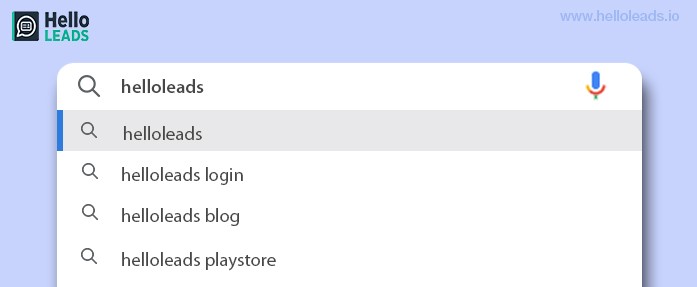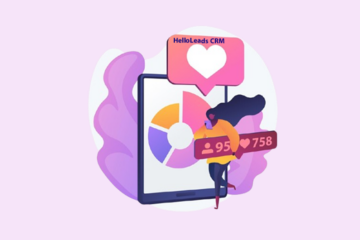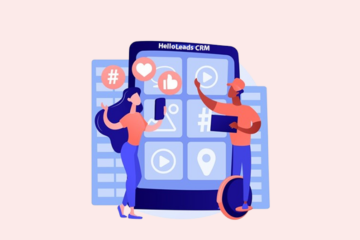
Have you ever been frustrated with your competitor’s website which outranks your website?
In today’s digital age, you need to create a strong online presence to win more leads and customers for your business. Digital marketing is one of the best and most effective ways to generate more leads for your business as it provides a global reach and visibility of your brand, product, and services.
Search Engine Optimization (SEO) is an important part of digital marketing that can help in getting higher search ranking and driving more traffic to your website.
When entrepreneurs and small businesses get SEO right, they can see lifts in website traffic, brand visibility, and revenue. This makes for more sales opportunities and stronger growth.
Are you a small business owner looking to get started with SEO?
In this small business guide, we will walk you through the basics of SEO for small businesses explaining each term and phrase that you should be aware of.
Search Engine Optimization (SEO)
SEO is the process of increasing the quantity and quality of website traffic to your website through organic search engine results. It helps to increase the visibility of the business. 93% of online experiences begin with search engines.
Importance of SEO to businesses
There is a popular joke in the online industry is that, if you want to hide a dead body, you should hide it on the second page of Google. Because, a fraction of people go to the second page of the Search Engine Results Page (SERP) and if your industry is not on the first page of Google, your competitors will take all your customers.
Click through Rate (CTR) decreases gradually with each position. If you want your business to be successful in the online world, it is very important to have a well-optimized website. One big advantage of SEO against Pay-per-click (PPC) is, even if you stop your SEO activities today, your results won’t stop tomorrow, unlike PPC.
SEO is very important for businesses if you want to make more sales without high marketing costs.
Local SEO
Local SEO is targeted towards users and potential customers who are interested in local searches for a business’s products or services. These include location-based queries and results. For example a vegan restaurant in New York or a plumber in Manhattan.
Search Engine
According to Google, a Search engine is “a program that searches for and identifies items in a database that correspond to keywords or characters specified by the user, used especially for finding particular sites on the World Wide Web”.
Search engines answer the queries entered by users and give them a list of relevant results based on various factors.
Few search engines other than Google
Popular search engines other than Google are Bing, Yahoo!, DuckDuckGo & Yandex. There are so many types of search engines. For example, YouTube is a search engine that only results in video results. If you consider based on traffic, YouTube is the second most popular search engine in the world.
Most important Google Ranking Factors
There is no definite, concrete answer for this. Everything we know is based on experiments and industry best practices. They include
- Quality Content
- Quality & Relevant Backlinks
- Mobile First
- Page Speed
- Brand Strength
- Domain Strength
- User experience
- Technical SEO
- Social Signals
- Content Freshness
- Schema Code
- HTTPS
- Domain Authority
- Content-Type
- Content Depth
Web crawling
Web crawling is the process where search engine bots crawl websites for indexing. Those are called a spider or spider bot. It uses hyperlinks to visit pages and copies them for processing and indexing by the search engine so that users on the Internet can search more quickly and efficiently.
The more fresh content you produce, the more frequent your website will be crawled from search engines.
SERP
SERP stands for Search Engine Results Page. When you search anything on search engines, this is the page where you can see all the results. SERP includes PPC listings and organic listings. Listings are available in multiple formats based on the keyword.
Organic result
Among the two types of search results in SERP, organic results are displayed by search engines based on relevancy, quality, and other ranking factors. Organic results are unpaid results and are also called ‘free results’, ‘natural results’. The ranking of organic results is based on various factors. Organic results can be seen under the paid results. You can’t manipulate organic results by paying Google but can be improved by having high-quality content and improving user experience.
Paid result
Paid results are one where advertisers pay to get their ads displayed above organic results on SERP. Paid results are quick and advertisers don’t need to optimize their website, content to rank. The position will be based on your Max CPC and your quality score. The more quality score you have, the less money you need to pay.
Google Sandbox
Google Sandbox Effect is a theory that states new websites are normally in the probation period (inside a box) and cant be able to rank well for their most important keywords. The theory states Google needs some time to observe before taking it out of that imaginary area. It may be caused by building too many links within a short period. It has never been announced officially but was mentioned by Google.
Google Auto complete

Google Autocomplete is a function in Google and other search engines. When a user starts typing in the search box, the Google autocomplete function gives you a list of options to complete your search.
The search suggestions are based on popular searches and also based on your search history.
Googlebot
Googlebot is Google’s web crawler to find, crawl, and index web pages.
Googlebot is also referred to as a spider. The job of Googlebot is to crawl every webpage that allows it access and add it to Google’s index. Once a website is indexed by Googlebot crawlers, it can be accessed by the users on SERPs based on their search queries.
Googlebot is the general name for two different types of crawlers: a desktop crawler that simulates a user on a desktop, and a mobile crawler that simulates a user on a mobile device.
DA
DA stands for Domain Authority (metric developed by MOZ) is a search engine ranking score that ranges from 0 to 100. The score predicts how well a website will rank on SERP. The higher your DA, the better chances you have at ranking higher.
DA is still an important metric for SEOs. They use it to quickly understand the quality of websites. It helps them to compare multiple sites and understand their authority.
Difference between DA and PA
| DA | PA |
| DA is Domain Authority. It explains the authority of your entire website. The higher the DA, the higher the possibility of ranking. But, DA is one of the hundreds of ranking factors. | PA is Page Authority. It explains the authority of a specific page, based on the backlink, social sharing, etc. |
Domain
A domain name is an address where internet users can access your website, and it includes web addresses, email addresses, and the addresses of the Internet protocols. It is a shortcut to the server that hosts your website. For example, Google.com is easy to remember than “74.125.127.147″.
A domain name has two main elements:
- The website’s name (e.g., HelloLeads)
- The domain name extension (e.g., .io)
TLD & ccTLD
Top-Level Domain (TLD) is the final part of an internet address. There are different types of TLD are available like .com, .net, .org, .co.in, etc.
ccTLD is a country code top-level domain. Each country has its own domain extension. All ccTLDs are just two characters. For example, .in for India, .us for USA.
URL
URL stands for Uniform Resource Locator. It is the address of a web page or document on the www. URL that has multiple parts. It begins with the protocol (HTTPS, http, etc).
Multiple components of URL:
- Protocol : The method used to process the URL (https, http, etc)
- Domain : The domain name (ex: upgrad.com)
- Path : The folder and page of the website
- Query string : Parameters for dynamic data
- Hash : Find the specific section of a webpage.
White Hat SEO

White Hat SEO is a process of improving your search engine rank following the guidelines of search engines without compromising on your methods. White Hat SEO
doesn’t involve manipulating search engines with shady methods but instead involves building search engine-friendly websites and user experiences. White hat involves creating quality content that provides value to the visitors and helps them to earn links instead of building backlinks.
The list of methods that are following Google’s guidelines is called White Hat SEO.
Black Hat SEO
Black Hat SEO is a process of trying to manipulate search engine algorithms to improve the search engine ranking. It violates search engines’ guidelines. Black Hate SEOs practice the methods to get immediate results instead of building a website with users in mind. There are so many Black Hat SEO methods they utilize and search engines identify and offer penalties if get caught. Black Hat methods might be helpful in the short term but if you are planning for the long term, black hat definitely is not the solution. If your site gets penalized, it takes so much time and effort to remove it.
Black hat SEO practices to avoid include Cloaking, keyword stuffing, link exchange, buying links, PNB, link hiding, link farming, gateway or doorway pages.
Private Blog Network (PBN)
Private Blog Network is a website built on dropped or auctioned domains. Some black hat SEOs build them to link to their important website and transfer authority.
Google is against this method as it can uplift a spammy website so they are most often hidden from search engines.
SEO tools
SEO tools analyze the performance of web pages and give insights for high placement on the SERP. The most popular and important SEO tools are Google Analytics, Google Search Console, Google Keyword Planner, Bing Webmaster Tools, Ahref, SEMRush, Alexa, Moz, Buzzsumo, UberSuggest, Screaming Frog, and more.
(i) Google Search Console : If you are an SEO, you need to master the Search Console. It helps you to check your website health in the eyes of Google. It helps you to analyze the performance of your website and helps you optimize it better. It helps you to find the list of errors in the website. It is a completely free tool from Google.
(ii) Google Analytics : Free version of Google Analytics is sufficient if your website is mid-level. It helps you to understand the performance of your website, understand the behavior of the visitors, help you perform better in terms of conversions, and so on.
Apart from these free tools, some notable paid tools are
(iii) Moz : It helps businesses to analyze and get insights about their websites and their competitors.
(iv) Ahrefs : Ahrefs is the best tool if you want to check your or your competitor’s backlinks.
(v) SEMRush : SEMRush helps you check the health of your backlink, the position of your keywords, and errors in your website.
(vi) Screaming Frog : It crawls your entire website and lists out all key elements like internal links, external links, titles, descriptions, HTTP status code, and more.
(vii) UberSuggest : Ubersuggest is a FREE chrome extension and a powerful SEO tool that shows you keywords monthly search volume, CPC & competition data.
The Uber suggest extension will not only provide you with insightful data related to a specific keyword query on Google but also sites like YouTube, Amazon & more.
Do-follow link & No-follow links
Do-follow is the default hyperlink. When search engines finds a Do-follow link, it crawls the page and pass authority (also called as link juice) from one website to another. More do-follow links from high authority sites means possibility of better ranking in SERP as backlink is still an important ranking factor.
Example of a do-follow link:
<a href=”https://www.upgrad.com”>Do-follow link Example</a>
No-follow is another type of backlink where webmasters can tell search engines that not to follow the specific link.
Well, it doesn’t guarantee Google to not to follow the links. Businesses use No-follow link when they link social media sites or any other third party sites and don’t want to pass their link juice to those websites.
A Do-follow link passes the link juice from one domain to another and the no-follow link doesn’t pass the link juice. A Do-follow link is more valuable in terms of SEO and No-follow links are less valuable.
On-Page SEO
On-Page SEO is the list of activities performed in the website to increase the performance of the website in ranking, user experience and conversion. Primary aspects of on-page SEO include making surePage title, Meta descriptions, Meta tags, URL Structure, Body tags, Keyword density, Image, Internal linking are in order and good.
Off-Page SEO
Off-Page SEO is the list of activities performed away from the website to improve the ranking and visibility of the website. Primary aspects of Off-Page SEO includeGuest Blogging, Reverse Guest Blogging, Social Networking Sites, Press release, creating backlinks etc.
Critical meta tags
The page title and the meta description are the critical meta tags. The page title (sometimes called SEO title) plays an important role in ranking but it is also important because it is the title that shows on the Search Results Page (SERP). It must use a keyword to rank well with Google but it must also be compelling so a user will want to click on it. The meta description does not affect ranking, but it also plays a role in the SERP because it also must make the user want to click on the search result. You should also mention that Google recently increased the character length limit of meta descriptions to around 280 to 320 (no one is sure of the actual limit yet).
SEO writing
The usage of keywords and key phrases within a website’s content is known as SEO writing. This helps increase the organic visibility of the website on the SERP.
Keywords
Keywords are words or phrases search engine users use to find relevant content. They are also known as queries.
When we figure out the list of keywords your potential users use, after the complete analysis, we have to implement those keywords on relevant webpages and optimize it to rank higher on search engines.
Keyword frequency
Keyword frequency is the number of times a specific keyword phrase appears on a web page. While optimizing a web page, we have to make sure we don’t use the keyword so much that becomes keyword stuffing.
Keyword Difficulty
Keyword difficulty is a metric to define how difficult it is to rank for a specific keyword-based on its popularity and competition. Higher the keyword difficulty, more time or number of backlinks might be needed.
Keyword Proximity
Keyword Proximity tells the distance between to keywords on a web page.
Keyword Density
Keyword Density is the percentage of times a keyword or phrase appears on a specific web page. When the keyword density is far higher than the recommended level, it might trigger search engines to think it’s keyword stuffing. So, we need to make sure the keyword density is not too high for any primary or secondary search phrases.
For example, if a keyword appears 5 times in an article of 200 words, the density would be 2.5%. There is no ideal keyword density but 3-4% is considered as best practice for SEO.
Keyword Stuffing
Keyword stuffing is a black hat SEO method. Increasing the keyword frequency to rank for specific keywords is generally frowned upon and could get your website penalized.
Keyword Stemming
Keyword Stemming is a process of identifying the root word of a keyword and creating new keywords by adding suffixes, prefixes and pluralization.
Keyword Prominence
Keyword Prominence tells where your keyword is located in a web page. For example, in a blog section, it is better to have your keyword in the article, especially first and last paragraph.
Keywords on a page
It is good to have three primary keywords and some secondary keywords, but it shouldn’t look unnatural within the content, and the number of keywords to be used depends on the content length, page flow, keyword difficulty, etc.
Ways to know if you are using the right number of keywords in a page
There is no right number or range. You have to make sure the keywords in the content looks natural and doesn’t look forced. It is a best practice to have 3 primary keywords and few secondary keywords and again, it depends on the length, keyword difficulty, competition, flow of the page and more.
Long tail keywords
Keywords can be made into a more specific combination of several words. These are called long-tail keywords. Long-tail keywords can be very specific and, hence, can be good for attracting quality traffic from people who are interested in that specific search query, and they are more likely to transform this kind of traffic into conversions.
NAP
NAP stands for Name, Address, Phone Number. NAP is one of the critical aspect of Local SEO. It helps search engines to understand and identify the list of companies to be displayed for specific location-based searches.
Bounce rate in SEO
Bounce rate is the percentage of website users who leave the website from the landing page without visiting any other page or without taking any specific action.
According to Google, Bounce rate is single-page sessions divided by all sessions or the percentage of all sessions on your site in which users viewed only a single page and triggered only a single request to the Analytics server.
To lower the bounce rate, increase the engagement on your page (with the help of internal links, call to action (CTA), etc), increase page speed, matching user experience and more.
Bounce rate benchmarks change from genre to genre. Blogs tend to have high bounce rates and B2B sites should have lesser. Benchmarks also change based on the industry.
Header tags
It ranges from <h1> to <h6> with H1 being the biggest and H6 being the smaller header. H1 and H2 is considered to be the most important for SEO.
It is recommended to utilize your secondary keywords in header tags wherever it feels natural and doable.
Meta descriptions
Meta descriptions are HTML attributes which conveys what the page is about. It provides the description about the webpage not only to search engines but also to users. Users can read the meta descriptions beneath the Title of the web page in search engine results page.
Meta descriptions are one of the important SEO tags where it is recommended to optimize for keywords. Apart from that, it is crucial to design a meta description in a way that users want to read more about your web page and thus improve your CTR.
Internal Links
Internal links are hyperlinks that connects one webpage to another webpage of your domain. Internal links structure is very important for both user experience and search engines.
Internal links structure should be well planned keeping users in mind so they can navigate the website without any confusion. Keep every important page within 2, 3 clicks from the home page. Link Depth is the number of clicks required to reach a page from home page. Keep all your important key pages links in the home page.
Internal links help search engines to crawl and index the web pages of the website and helps link juice pass from one page to another. If properly optimized, the right placements of internal links reduce the bounce rate of the web page.
Outbound links
Outbound links are links that links your website to another website.
Having too many outbound links might hurt your SEO as they pass link juice from your domain to another domains. It is recommended to have no-follow links to outbound links to avoid passing on authority.
Keeping few outbound links to high authority sites might be helpful as you tell search engines more about the content you have and it creates a connection from your website to other relevant websites.
Inbound links
Inbound links are links coming from another domain to your own domain.
Link building
Google exists to serve the searcher. That means Google is constantly trying to determine which results are most relevant to any given searcher and any given time. In addition to relevance, Google considers credibility too. So the search engine looks to see if other websites have linked to yours. If so, that means your content is worth linking to and is, therefore, more credible when compared to a website not linked to externally. In a nutshell, link building is what SEO professionals do to try and get links to their websites in order to improve search results.
Backlinks in SEO
When one website links to another website that is called as backlinks. Backlinks are an important SEO ranking factor. There are two types of backlinks. No follow and Do follow backlinks.
When a web page gets multiple relevant backlinks from authority sites, Google and other search engines consider the page to be more relevant to the search query, thus improving the rank of the web page.
The number of backlinks is not always important but the quality and relevancy make a big impact.
Importance of Backlinks
Google considers backlinks like a vote. The more backlink a website has, the more popular and important it is. But as we mentioned in the early answer, just the number is not the only factor. There are so many other factors that decided how much value every backlink brings to your website. The authorization of the website, the relevancy of the website, the value of the page where we get backlinks from, the location of the page where we get backlinks, and so on.
One high-quality backlink is more valuable than ten low-quality backlinks. If you are into ERP businesses, the links you get from websites/blogs related to ERP has more valuable than non-ERP-related websites.
Robots.txt
Robots.txt is a text file. It is through this file, it instructs search engine crawlers about indexing and caching of a webpage, file of a website or directory, domain.
Anchor texts
Anchor text is the clickable text in a hyperlink. Anchor texts help users to understand what the page is about. It also holds SEO value if keywords are implemented. But in case of over-optimized, might get punished by Google.
Anchor text should be natural and diversity is important like branded, long tail, image links, partial and exact matches.
Search engines use anchor text to understand the context of the page it is linking to. This holds some SEO value in terms of understanding search engines what the page is about.
Title Tag
Title tag helps Google and users to understand the purpose of a web page. Optimizing page title is an important on-page task where it’s recommended to use your primary keyword. Also, the title tag should be good enough to make search engine visitors click on it and visit your web page.
SEO Friendly URLs
SEO Friendly URLs are URLs that are easy for both search engines and users to understand. URLs that are static instead of dynamic, without parameters, keyword-optimized, reader-friendly & short.
Robots Meta Tag
Robots Meta Tag tells the search engines how to treat the page with commands like FOLLOW, NOFOLLOW, INDEX & NOINDEX.
Methods to redirect a page
In general, 301, 302, and Meta Refresh are the three most widely used redirects.
301, “Moved Permanently”—recommended for SEO
302, “Found” or “Moved Temporarily.”
301 redirect is a permanent redirect method to redirect users and search engines to redirect from old URL to new URL. When a webmaster wants to redirect from one URL to another for various reasons, 301 is considered the best as it passes most of the link juices from the old page to the new page.
301 is better for SEO compared to 302 or other JS-related redirects in terms of passing authority and value.
Search Console / Webmaster Tools
Google Search Console, previously known as Webmaster Tools is a tool Google provides to webmasters to check the health of their website in the eyes of the search giant.
Not only webmaster can analyze the various aspects of the website like checking indexing status, crawl errors, crawl status, keyword performance, backlinks, but also can be able to disavow URLs, apply for page reindex, upload XML sitemap, etc.
ALT Tag
Alt tag is an HTML attribute that helps us to give a description to every image you publish on your website. If any reason, the image cannot be displayed in the browser, users can read the alt tags and understand what the image relates to. It also helps search engines to understand what the image is about, which helps them to understand more about the page. ALT tags can increase the ranking of the website’s images in the ‘image search’ of search engines.
Search Engine Submission
Search engine submission is the process of submitting your website to popular search engines to make sure it gets crawled and indexed.
But, this process is not necessary anymore as search engines are way smarter and have the capacity to find your website and index easily without you needing to submit it to them manually.
Forum Posting Forum posting is an off-page technique where you create a profile on a relevant forum, create a thread, engage with other users, participate in online discussions to get backlinks to your site. This could have been a great way to reach out to potential users and engage but some advertisers spammed the process and thus lost its trustability.
But still, if you can engage with users and educate them, clear their doubts, help them find the solution, we can still utilize this method.
RSS Feed
RSS Stands for Really Simple Syndication. RSS Feed submission is the process of submitting RSS feeds to the RSS submission directory. It is helpful for users to get updated on multiple blogs, websites, and news from a single location. The usability of RSS is very limited now and the way people consume content has changed over time.
Blog Commenting
Blog Commenting is a process of adding comments on blog posts with a relevant backlink to your website.
There are two types of blog commenting. Automated and Manual. Automated blog commenting is usually a scammy process where you don’t read a blog post and comment on a mass scale. It doesn’t add any value to the reader or publisher. Manual commenting is when you select relevant sites, read through the blog post, add your opinion in the form of a comment, engage with the author and share your relevant blog post/page which can be helpful to other readers.
SEO Value of blog commenting
It is obvious that the value, practice of blog commenting is not how it is used to be. The links don’t hold any value as they are mostly no-follow these days. It can only be valuable if you choose the right blog, share the right link, and if people follow your page based on that link.
Referral traffic
Referral traffic is the visits you get from third-party domains. You can improve the referral traffic by building or earning links from potential and relevant websites.
Directory submission
Directory submission is an off-page SEO technique still getting utilized by some businesses. It works only if your business is getting listed on popular directory websites where people actually look for businesses. Listing the website in dozens of websites just to get backlinks is an old concept that should be avoided.
You can submit your website to a niche-relevant directory for citation if it’s a local business.
PPC
Pay Per Click or PPC is a kind of advertisement campaign in which advertisers are charged when users click on the advertisement. The amount charged on the advertiser is called Cost Per Click (CPC). Most PPC advertising will include a CPM component as well. CPM is an abbreviation for Cost Per Mille, or cost per thousand Ad impressions.
There will be a small cost charged on the advertiser when the Ad gets thousands of views.
CTR
CTR stands for Click Through Rate. We can get the CTR by dividing the number of impressions by the number of clicks. For example, if you have got 15 clicks out of 150 impressions your CTR would be 10%. CTR is not a direct ranking factor but in a long run, it can improve the ranking on SERP.
Exact Match Domain (EMD)
EMD or Exact Match Domain is a domain that includes the search phrases. For example, when someone is searching for Buy Tablets Online, an Exact Match Domain could be BuyTabletsOnline.com
Difference between page rank and Search engine result page
Page rank is a Google algorithm. This is a metric for measuring the performance of a webpage submitted by webmasters to search engines. Google discontinued revealing the page rank to the world.
SERP or search engine results page lists the pages that relate to any query made by the user. These results include both organic search as well as paid results. The results in the SERPs hold some positions, and these are not just random positions. The ranking positions are decided by the search engines using sophisticated algorithms, and page rank are one of them.
HTML Sitemap
HTML sitemap is a new website that allows people to view a list of pages structured to understand and traverse the site quickly. An HTML sitemap isn’t essential if your website has a few user-accessible sites. HTML sitemaps are very beneficial if you have a large website.
XML Sitemap
Extensible Markup Language (XML) is an acronym for “Extensible Markup Language.” The purpose of an XML sitemap is to provide search engines with information about the most recent changes made to them. It contains a list of websites and the frequency with which they are updated. Using an XML sitemap, we may request that search engines regularly scan and index our essential pages. When a search engine discovers a website, among the first things it looks for is a sitemap.
LSI (Latent Semantic Indexing) keywords
LSI Keywords or Latent Semantic Indexing keywords are semantically linked to the principal term used by visitors in search engines. When we use LSI keywords to improve a page, the keyword relevance will rise. LSI allows you to optimize keywords on a web page without worrying about keyword stuffing. Google’s algorithm uses LSI keywords to determine the relevance of a search phrase. It aids search engines in deciphering the semantic structure of keywords and extracting the meaning of the text to provide the best SERP results.
Factors to make website search engine friendly
Several factors make a website search engine friendly, including keywords, quality content, titles, metadata, etc. A website needs these factors to be ranked by a search engine and therefore found by a user.
Canonical URL
If a page is accessible by several URLs or several pages have similar content (e.g., pages with both mobile and desktop versions), Google will see these as duplicates and will pick one as the canonical version to crawl unless you specify the canonical URL.
Google Penalty
Google executives manually penalize websites when they are observed to be violating any Google guidelines. Notifications are sent via Google Search Console when such breaches happen. It takes so much time and effort to lift the penalization that it is better not to get penalized in the first place.
Schema markup
Schema markup is a piece of code that you put on your site to help search engines display additional information to users on SERPs.
Cloaking
Cloaking is a black-hat SEO technique used to display to users the content that is not what is presented to search engine crawlers to manipulate search engine rankings for certain keywords.
Page speed
Page speed refers to how fast your site loads for a user, something Google takes into account while ranking websites since a faster loading page directly translate to a better user experience. To increase page speed, following some techniques such as reducing image sizes, enabling compression, reducing redirects, removing render-blocking JavaScript, leveraging browser caching, improving server response time, using a content distribution network to compress files, optimizing the code, etc. is important.
SEO for a video
Videos are growing increasingly popular on the web, which can improve SEO if the videos produced get attention and therefore share and backlinks. But to get the video seen can require SEO to get it found, and Google can’t watch a video. It needs the same types of information required for text-based pages to rank a video. Including the transcript as a text is an easy way to do SEO for a video because search engines can crawl the text. In addition, the same attention should be paid to keywords, page titles, and descriptions.
SEO and SEM
SEO stands for Search Engine Optimization and SEM stands for Search Engine Marketing. The biggest difference between the two is that SEO is free and SEM is paid. SEM includes pay-per-click advertising and display ads that are purchased. Despite the major difference between the two, they work best in unison.
Canonical issue
Canonical issues are most frequent when a webpage/website has many URLs that contain the same or comparable information. A lack of correct redirects frequently causes them, but they can also be created by e-commerce search criteria and syndicating or distributing material on several sites.
Rich snippets
Rich snippets are the featured text that appears at the top of the organic search results, in a box, and sometimes with an image. Webmasters can use structured data to mark up content so that search engines can easily identify the type of content and deliver it as a rich snippet. Rich snippets are not part of SEO, but if used, they can deliver better results on the SERPs.
Accelerated mobile pages (AMP)
Accelerated Mobile Pages (AMP) is an open-source initiative that aims to boost the performance of mobile web pages. Twitter and Google were the driving forces behind the initiative. The technology underpinning AMP allows for lighter, faster-loading websites for smartphone and tablet users.
Final thoughts
Learning the basics of SEO is an important step in achieving your online business goals- that is improving the number of leads for your small business from your website.
Any business has a twin challenge (1) Generate as many leads as possible and (2) Convert as many leads to paying customers. While SEO helps with generating leads, www.helloleads.io helps you convert leads into actual long-lasting customers.
Also check out: Top 9 SEO hacks that small businesses shouldn’t miss
Share this blog :










